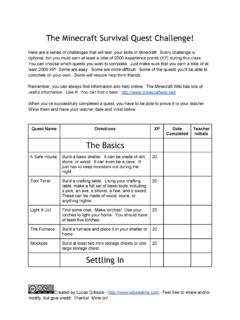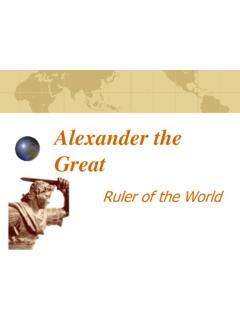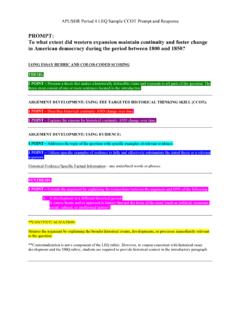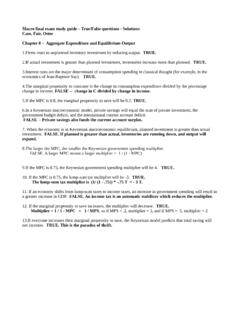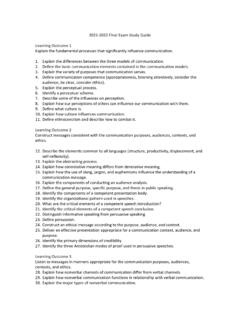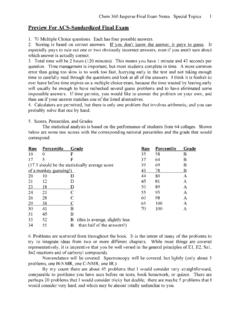Transcription of Physical Science Final Exam Study Guide
1 1 Physical Science Final Exam Study Guide I. Chemistry 1. What is the difference between a homogeneous mixture and a heterogeneous mixture? 2. List 2 examples of a homogeneous mixture and 2 examples of heterogenous mixtures. 3. List 2 examples of a pure substance and 2 examples of a mixture. 4. Where are metals, nonmetals, and metalloids located on the periodic table? Be specific! 5. List 2 formulas for an element and 2 formulas for a compound. 6. Compare these phases: Particle attraction? (how tightly are their molecules packed?) Particle motion? (How do they move/how much do they move within the substance?) Explain the gain or loss of heat when going to next So, what does this gain or loss of heat do to the attraction of the particles?
2 Solid Liquid Gas 7. Phase changes: Please complete this table: Phase change? (solid to liquid to gas, etc.) Is energy taken in (endothermic) or released (exothermic)? Melting Vaporization Condensation Freezing 2 8. Compare evaporation, vaporization, and boiling. Watch this Youtube video: See this table to help with your comparison Vaporization Boiling Evaporation This is the only one that is an ACTUAL phase change Energy is NOT involved with this process. This is not technically a phase change, but it is when a liquid changes to a gas due to changes in pressure. This is when the particles on a surface are exposed to wind and a liquid changes into a gas below its boiling point This is the phase change of a liquid turning to a gas.
3 9. Compare the formation of a solution and the formation of a compound. Which is a chemical process and which is a Physical process? 10. A solution forms due to forces of (CHOOSE ONE) (gravity, attraction, or energy) between the two types of particles that make up solutions. These two types of particles are (CHOOSE TWO) (protons, neutrons, solutes, solvents). 11. A material is _____ due to the LACK of ATTRACTION between particles. 3 12. Please answer the following questions based on this solubility curve: a. Which is more soluble, NaNO3 or KCl? b. How does the line drawn for a particular substance relate to the saturation of a solution of that substance? c. How many grams of NH4Cl will dissolve in 100 grams of 90 C Water?
4 D. How many grams of NH4Cl will dissolve in 50 grams of 90 C water? e. How many grams of KClO3 will dissolve in 300 grams of 30 C water? f. How would you make a saturated solution of KNO3 at 60 C in 50 grams of water? g. If I asked you to make a saturated solution of KCl in 100 grams of water, what other piece of information would you need before you could start? 13. Complete this table: Cannot hold any more solute in that given solvent at that given temperature. Holds more solute than that solvent can usually hold at that temperature. Holds less solute than that solvent can hold at that particular temperature. Saturated Unsaturated Supersaturated Dilute Concentrated 4 14. Explain how you could separate a mixture using solubility, density, boiling point, and magnetic properties.
5 15. Please complete this table: Metal Nonmetal Metalloid Definition, if necessary State of matter at room temperature Density (high or low) Melting points are Boiling points are Lustrous? Conductive? Ductile? Malleable? Color? Reactivity? 16. Compare some Physical and chemical properties of: Physical properties Chemical Properties Salt 5 Sugar Baking soda Corn starch Rubbing alcohol Water 17. Complete this table: Charge Mass? Location Proton Electron Neutron 18. Compare the number of protons, neutrons, electrons, and mass number in neutral atoms vs. ions 19. Explain how the different mass numbers of isotopes contributes to the average atomic mass for a given element.
6 20. Show 3 ways to write the symbol for a carbon isotope that has a mass number of 12. 21. Draw Bohr models of Sodium and Hydrogen. 22. Draw dot diagrams for chlorine, helium, and argon. 23. How many valence electrons do the following atoms have? Be, K, B, Si, As, Te, I, Kr 24. What are these atoms oxidation numbers? 25. Why are tin and lead sometimes written Sn (II) and Pb (III) or Pb (II) (having Roman Numerals beside them)? 26. Which group contains the most reactive metals and which one is the most reactive? 27. Which group contains the most reactive nonmetals and which one in the most reactive? 28. Complete this table: Their Electrons are (shared/transferred, etc.) Formed between which type of atoms? (metals, nonmetals, etc.)
7 NaCl CO2 KBr Ionic Covalent Metallic 29. Write the formulas or the names for the following compounds. Make sure you follow the correct rules for ionic vs. covalent (molecular) compounds. sodium hydroxide P4S5 lithium oxide Si2Br6 iron (III) phosphide B2Si chlorine dioxide MgBr2 6 dinitrogen trioxide Zn(OH)2 iodine pentafluoride PbO 30. Please BALANCE and CLASSIFY these reactions: 1. 2 K + 2 H2O -----> 2 KOH + H2 2. HCl + NaOH ----> H2O + NaCl 3. KNO3 ----> KNO2 + O2 4. 2 C2H2 + 5 O2 -----> 4 CO2 + 2 H2O 5. C4H8 + 6 O2 ----> 4 CO2 + 4 H2O 6. Hg + O2 ----> HgO 31. How does the Law of Conservation of Matter relate to balancing chemical equations?
8 32. Match these acids and bases with their formulas: Calcium Hydroxide Barium Hydroxide Sodium bicarbonate Hydrochloric acid Nitric Acid Magnesium Hydroxide HCl H2SO4 C2H4O2 HNO3 C6H8O7 NaHCO3 NaOH KOH Ca(OH)2 Mg(OH)2 Ba(OH)2 NH4OH Sodium Hydroxide Ammonium Hydroxide Acetic Acid Potassium Hydroxide Sulfuric Acid Citric Acid HCl H2SO4 C2H4O2 HNO3 7 C6H8O7 NaHCO3 NaOH KOH Ca(OH)2 Mg(OH)2 Ba(OH)2 NH4OH 35. Arrhenius theory of acids and bases: Acids Bases Neutral Produce more OH- ions in solution than H+ Produce more H+ ions in solution than OH- ions Produce equal amounts of H+ ions and OH- ions in solution pH below 7 pH above 7 pH equal to 7 Reactive with metals Reactive with fats/oils 36.
9 What is a neutralization reaction? 37. Which 2 things are formed in a neutralization reaction? 38. Complete the table below with the correct information about each type of radioactive emission. Charge Atomic Symbol Can be stopped by Mass (large/small)? This decay Increases the atomic number by 1 This decay reduces the mass of an atom by 4 and the atomic number by 2 These are Electromagnetic Waves released from the nucleus with an alpha or beta particle. Alpha Beta Gamma 39. Complete the following nuclear reactions: a. 6027Co 0-1e + _____ Radiation type _____ b. 211___Fr _____ + 20785_____ Radiation type_____ 8 c. 8235____ _____ + _____Kr Radiation type _____ 40. Complete this table using the concepts you have learned about Fission and Fusion: Fission Fusion two or more nuclei join together to form a more-massive nucleus Uranium large nucleus splits into two smaller nuclei energy is released Chernobyl not currently used to provide electrical energy no radioactive waste products occurs in the sun s core radioactive waste products requires temperatures over 100,000,000_C fuels 20 percent of the electrical energy used in the United States not currently used to provide electrical energy 41.
10 Complete these half-life problems: II. Physics 42. Draw and label a diagram which shows the difference between distance and displacement. 43. Which is a scalar quantity and which is a vector quantity: Scalar quantity V ector quantity Speed Velocity Distance Displacement 9 44. The symbol for velocity is _____ The symbol for time is _____ The symbol for distance is _____ The equation for velocity is _____ The unit for velocity is _____ The unit for time is _____ The unit for distance is _____ 45. Please calculate the answers to these problems: 1 2 3 4 10 46. Momentum problems: 1. Calculate the momentum of a kg ball that is moving toward home plate at a velocity of 40m/s. 2. Which has greater momentum, a hockey puck moving east at or a hockey puck moving south at 47.



